The Best Salmon Recipe for Pregnancy
- February 23, 2018
- Last Updated: October 8, 2024
- 15 Comments
- Recipes
This pregnancy salmon recipe is quick and easy – things we value during pregnancy when our appetites and energy may not be ideal. See how easy it is to make and what to pair it with!
As an Amazon Associate, I may earn from qualifying purchases. You can read more here about our Disclaimer and Privacy Page.
Disclaimer – This post is for informational purposes only and is not for diagnosing or treatment. See your medical provider or Registered Dietitian for individual recommendations.
I’m excited to share this easy salmon recipe for pregnancy with you today. Plus, I wanted to make sure I acknowledge the importance of heart health before February ends because February is Heart Health Month.
This is a big one in the nutrition world because heart disease is the leading cause of death in the U.S.
I often compare heart healthy foods to pregnancy foods. And my favorite heart-healthy foods are seafood, like salmon, tuna and nuts/seeds.
So, let’s talk a little bit about eating salmon when pregnant. It also happens to be one of the best foods for postpartum recovery!
Is Eating Salmon When Pregnant Recommended?
Yes, salmon is okay for pregnancy and is a source of many recommended nutrients.
Pregnant women are recommended to eat 2-3 servings of fish/week (8-12 ounces), as long as it’s not high in mercury.
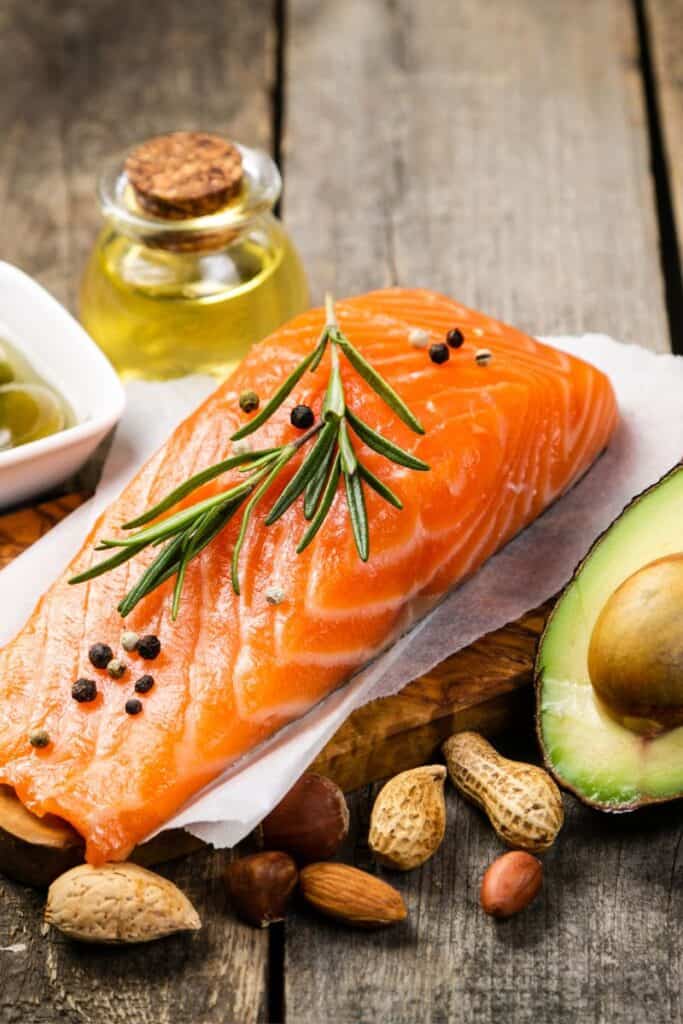
Many women think they need to stay away from fish completely because of the mercury, but really, it’s only specific high-mercury options, like king mackerel, swordfish, shark and tilefish.
While you can see more about the difference between dha and epa, know that it’s very important to consume these omega-3 fatty acids when pregnant, for your health and for baby’s.
Pregnant women also need to stay on top of hydration (and pregnancy electrolytes) and get enough quality calories. I drank so many pregnancy mocktails and smoothies because they made staying hydrated fun and flavorful.
Mercury Content in Fish
Some fish have lower levels of mercury than others. During pregnancy, it’s recommended to limit the seafood with higher amounts of mercury, like that found in certain types of tuna (albacore, yellowfin), snapper, rockfish, mahi mahi, halibut, grouper and more.
Mercury can be harmful because it collects in oceans and other bodies of water. Therefore, it may accumulate in some fish and act as a neurotoxin.
In high quantities to humans, it can be toxic to our nervous systems and can affect our babies. Mercury has also been linked to hearing and vision problems.

As with many things, it’s more harmful to us during vulnerable times, like pregnancy and growing a baby
Fish with moderate amounts of mercury are allowed about once/week.
The FDA recommends avoiding fish with the highest mercury levels, like king mackerel, shark, swordfish and tilefish. I don’t know about you, but those aren’t typically the fish I consume anyway.
The best low-mercury, heart-healthy choices include:
- salmon
- canned light tuna
- scallops
- shrimp
- flounder
- haddock
Research has actually shown that women lose out on greater health benefits by skipping seafood during pregnancy. Fish has a great cognitive impact on the baby, too!
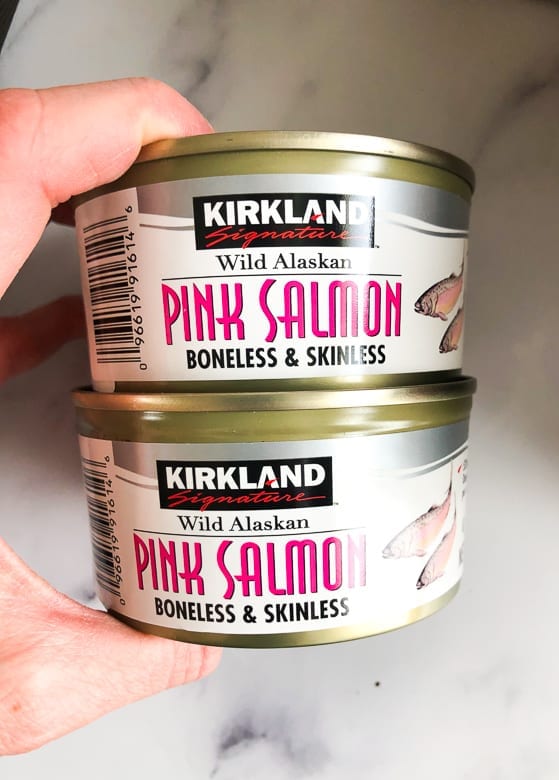
What are the Health Benefits of Seafood?
Low-mercury seafood options, particularly salmon, is full of omega 3 fatty acids.
Seafood provides many benefits for pregnancy, including lean protein, and nutrients like zinc, B-12, Vitamin D, Vitamin A, selenium, iron and iodine – all of which are vital for mom and the growing baby.
While most women may need to take omega-3 supplements during pregnancy, including omega-3 rich foods in the diet is very helpful and should be a priority.
Oftentimes, the foods have so many more nutrients to offer that work in concert, vs just taking an isolated supplement.
For example, consider starting the day with a healthy breakfast for pregnancy, like a bagel with lox.
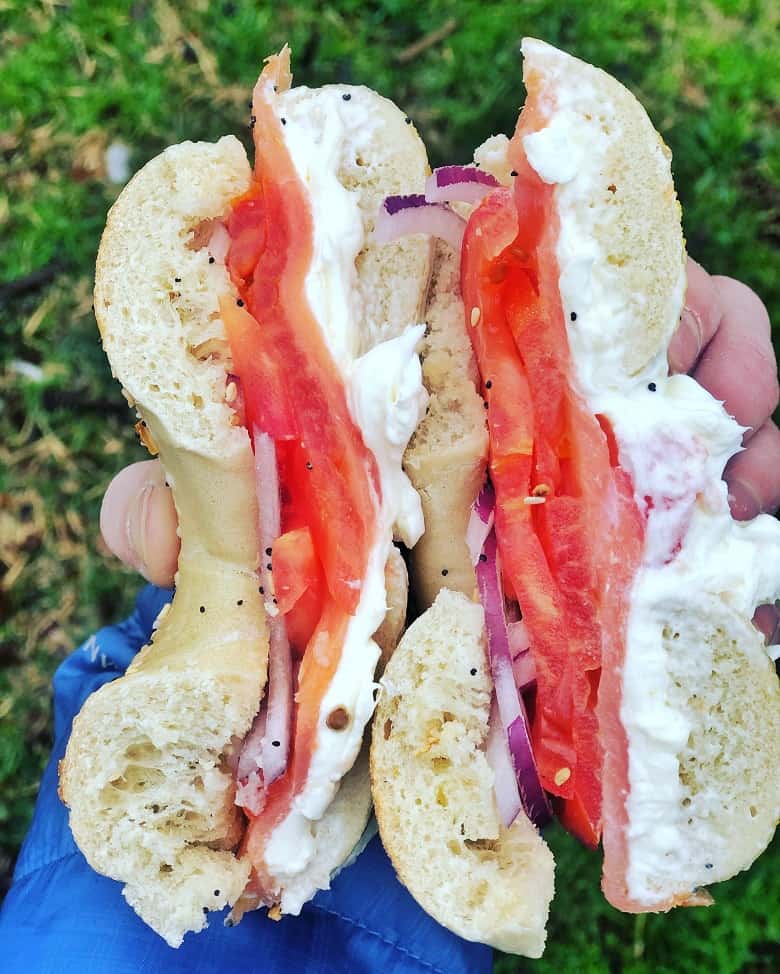
Why Are Omega 3’s important?
Omega 3 fats are essential, meaning we have to get them from our diets or through supplementation. Our bodies cannot make them.
The two omega 3’s that are found in fish are EPA and DHA.
- EPA helps with the heart, developing immune system and inflammatory response.
- DHA, on the other hand, supports the baby’s growing brain, eyes and central nervous system.
It’s common for women to experience increased blood pressure during pregnancy (due to the weight gain and blood volume), and omega 3’s can help with this.

Some research even shows that omega 3’s can lower the risk for pre-eclampsia and pre-term labor and delivery.
During pregnancy, there’s only so much you can control. For example, you can’t control how much weight you gain (more on my thoughts here), how big your baby is, what position your baby is in, medical complications, etc.
But, you can control what you’re eating and ensure you’re getting enough omega 3’s.

Which is why I love Pier 33 Gourmet’s seafood options. They have so many convenient options, ranging from Argentine shrimp, mussels ready in 10 minutes, to pre-seasoned salmon filets.
Making salmon during pregnancy easy with pre-seasoning is right up my alley!
I plan to share more about my pregnancy eats and updates in my update all about the pleasurable 35 week pregnant symptoms.
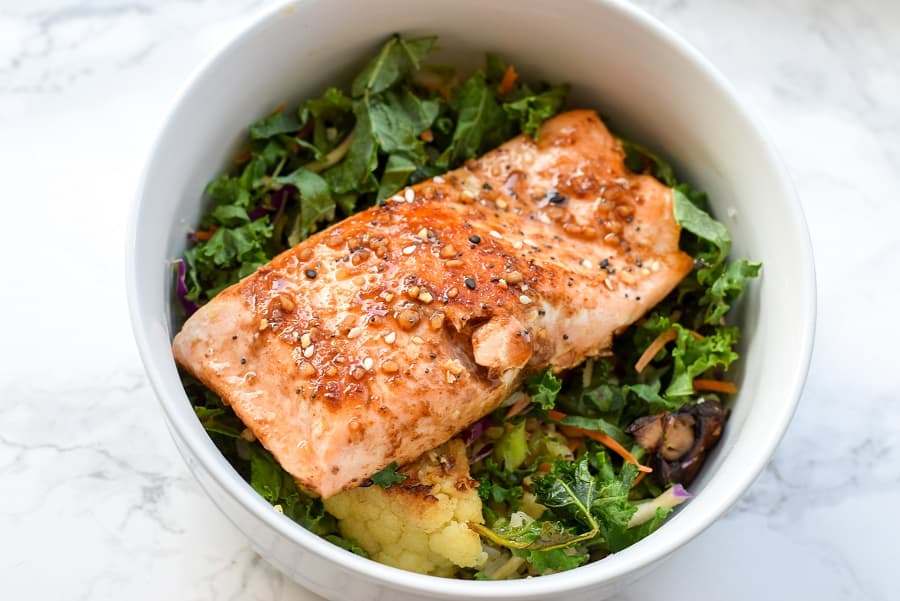
Easy Salmon Recipe for Pregnancy
Now that we understand the importance of seafood and salmon for pregnancy, let’s learn how to cook it quickly so it tastes delicious.
Lucky for me, I’ve always enjoyed fish and salmon. Since I’ve figured out how to make it a quick weeknight meal, I’ve been pretty consistent about getting my 2-3 servings of fish a week in.
Make sure to scroll down for the full recipe!
Learning how to cook fish has been so helpful for getting adequate omega-3’s and not having to rely on supplementation.
For this quick pregnancy salmon recipe, mix the marinade.
- balsamic vinegar
- maple syrup
- dijon mustard
- minced garlic
- sea salt and sesame seeds, optional.
Aim to cook your salmon about 3-5 minutes on the first side, and then the bottom side usually quicks cooker. So make sure to watch it!

The Best Salmon Recipe for Pregnancy
Ingredients
- 4 oz salmon filet
- 1 tbsp olive oil
- 3 tbsp balsamic vinegar
- 2 tbsp maple syrup
- 1-2 tbsp dijon mustard
- 1 tsp minced garlic
- sprinkle of sea salt
- sprinkle of sesame seeds
Instructions
- Mix the ingredients for your marinade. If you are prepping in advance, let the salmon sit in the marinade for up to 20-30 minutes.
- Place a cooking pan over medium high heat with a tbsp of cooking oil.
- Sautee the salmon in half of the marinade for 7-8 minutes, flipping halfway (and reserving the other half of the marinade for topping).
- Top the cooked salmon with sesame seeds and sea salt, and the other half of the marinade.
- Pair with rice, grains, or in a wrap!
Nutrition
Cooking Tips
- Cooking with sesame oil gives a nice flavor that complements the sesame seeds.
- I usually pour half of the marinade on the top half of the salmon while it’s cooking, and pour the other half over just before serving, but you can do it however you want!
- If I’ve planned for this recipe, I may let the salmon sit in the marinade for a few hours or even overnight (like my lemon pepper chicken tenders).
- I recommend to pair the salmon with rice, like lemon basil rice, or another grain and some greens and chow down! Or, add your salmon to this delicious broccoli kale salad.
And voila – super simple and tasty. Let me know if you give this recipe a try!
Support Bucket List Tummy

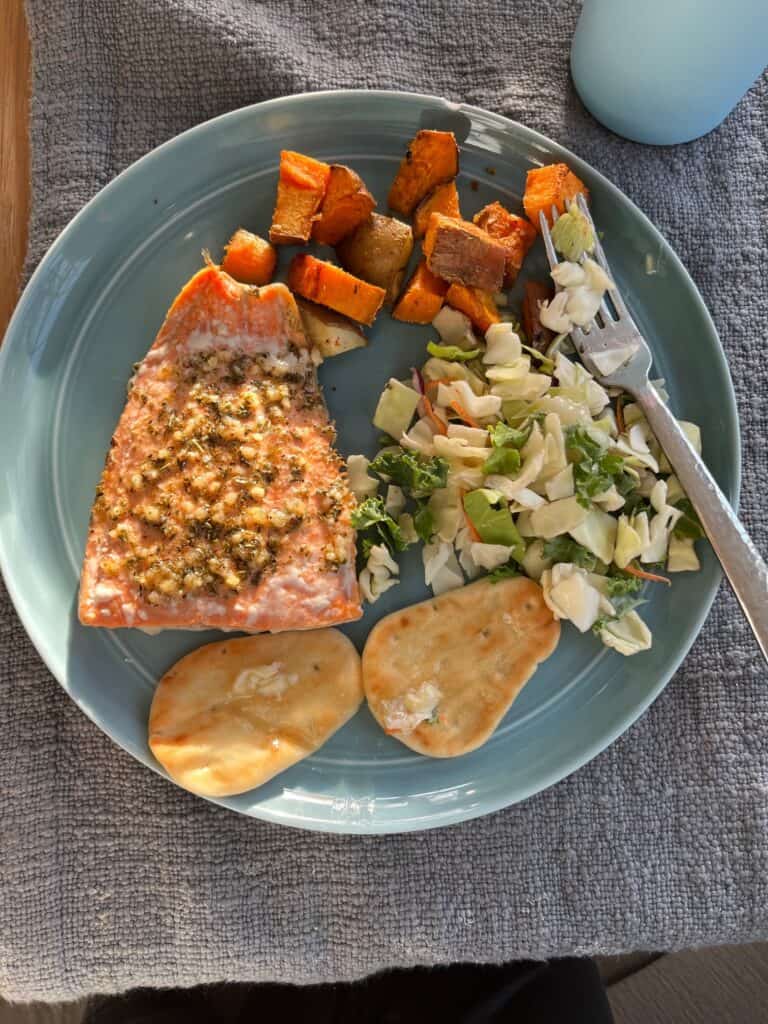


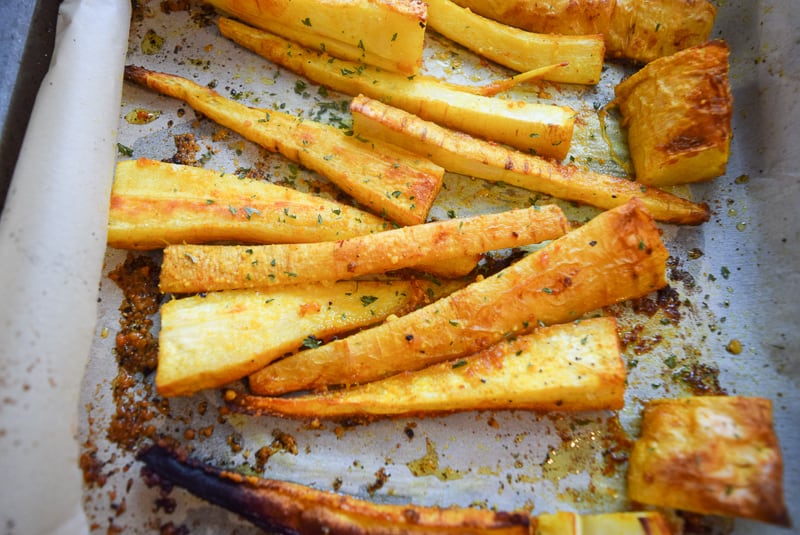


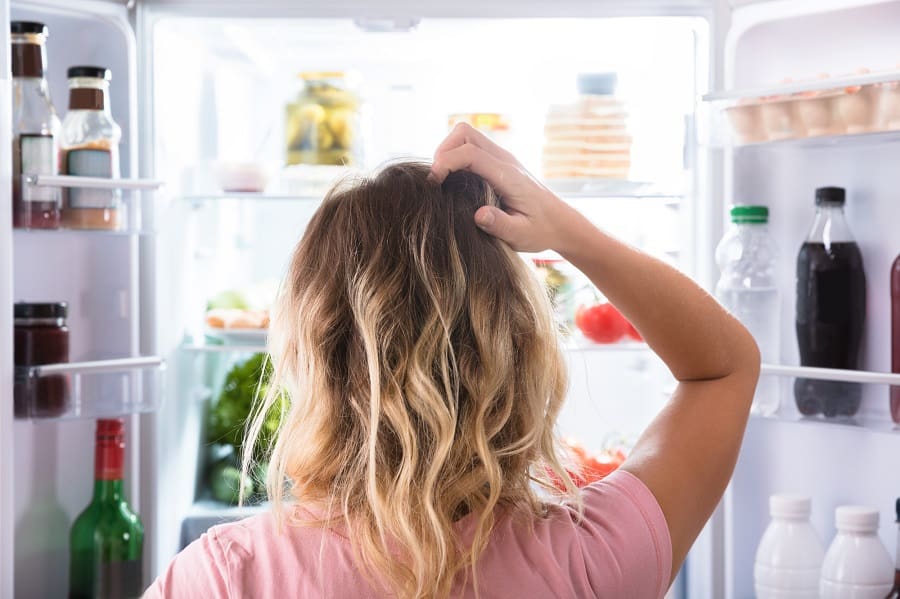
Like This Content?
Support Bucket List TummySuch a tasty recipe. Made it weekly during pregnancy. thanks!
I have a newly pregnant friend who was just talking about mercury in fish this weekend! Passing this onto her now!
How exciting! I hope she finds it helpful 🙂
I love baked fish or grilled fish! 🙂 I also like pan frying it, so I guess I’m game for anything!
I’m like you – I”ll eat it any way 🙂
So much great information and I love that infographic/printable!
I found it so helpful!
I love salmon, I wish the hubs liked it more. Skillet cooking it is probably my favorite, I like when it has a bit of a sear on it. Thanks for the recipe and info!
The sear can be delicious. Also, skillet is sometimes quicker and easier when I don’t feel like turning on the oven.
Pan frying Salmon is kind of an art, mine always ends up sticking to the pan and burning (I know more oil, less heat but I’m a high heat kind of person – no ideal in cooking) tonight is shrimp taco night though!
Haha, I love my olive oil so I never have a problem using more oil. Fish cooks pretty quickly, too!
Great, simple recipe!
With mercury levels, do you know – is it more to do with the fishing company/brand/source, or more to do with the type of fish? Should cans etc. have labels on them saying “no mercury” etc? Or, how do we watch this?
That’s a good question! I think certain fish have naturally higher levels because they eat other fish (i.e. shark, swordfish, king mackerel, etc). However, all fish are exposed but the lower levels generally aren’t as worrisome. But, I think environmental factors can also play in – like some areas may have more mercury released through industrial pollution, which can fall into the waters too. There’s some interesting info here: https://www.fda.gov/food/foodborneillnesscontaminants/metals/ucm351781.htm
I actually don’t eat seafood but I know Omega-3s are so good for me. Is there anything to look for in a supplement that makes it “good” or “bad”?
Supplements can be tricky because they aren’t regulated by the FDA! If you can find a USP verification label, that’s always a good sign that means it’s been third party tested and vertified.